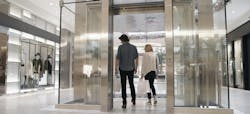Elevator Innovations Bring Efficiencies and Greater Return on Investment for Building Teams
The demands on commercial building owners and developers are daunting: Make a smart investment. Build a more efficient building. Meet tenant expectations. Prioritize profitability. These demands make specifying require products that offer sustainability, reliability, and durability key to tenant satisfaction and long-term investment results.
Elevators are a prime example. Seamless operations are vital to owners, contractors, facility managers, and tenants. Elevator reliability, a smooth ride, and tenant satisfaction are key considerations, as is reducing the total cost of ownership.
Collaboration is critical. AEC firms know the best building products benefit the developer both during and long after construction is complete. Installation must be exacting with stellar service. Products need to be backed by manufacturer representatives and technicians who are committed to saving the customer money and trouble, from purchase through the product life cycle.
Building Teams should invest in quality elevators with features that reduce unplanned service calls. Statistics show that more than two-thirds of elevator callbacks result from door malfunctions. These quickly add up and can increase monthly and overall maintenance costs. Many consultants predict that the average elevator installed today has an expectancy of 20 years or less while those top-tier manufacturers design elevators that could last beyond 30 years in the United States.
Building owners and developers seek elevators that help maintain focus on operational and financial efficiencies. One example is manufacturer Mitsubishi Electric, which has been providing building products, including elevators and escalators, for 30 years in the United States. Mitsubishi Electric elevators deliver a world-class ride in terms of comfort reliability and safety, and is proven in reducing the total cost of ownership. The company is also the only one that manufactures spiral escalators.
Sustainable design remains as important as ever, and facility manager and building owners work to maximize energy efficiency wherever possible. Mitsubishi Electric utilizes a regenerative converter on gearless traction elevators, which allow the unit to generate power when a fully loaded car travels in the down direction and when a lightly loaded/empty car are traveling in the up direction. The regenerative converter transmits power back into the distribution transformer and into the electrical network, with a power saving effect of up to 35% compared to a similar unit without this feature.
To ensure greater reliability and less scheduled maintenance, Mitsubishi Electric developed an innovative door operation system that employs a highly efficient “one-chip RISC microcomputer” which detects the constants variations on each floor in the door load, strength of wind, and even sediment in the sill grooves. This innovative advanced door control system is even isolated from the cab, allowing for a smoother more quiet operation. The company prides itself on best-in-class features and an industry-leading average callback rate of less than one per year per elevator. Low callbacks have the added bonus of reducing facility managers’ stress levels, improving end user satisfaction, and reducing building operating costs. Reliable elevators are a win-win for manager and tenant.
Buildings with high-quality elevators that provide maximized uptime result in more satisfied tenants and stress-free building operations. Enhancing elevator efficiencies and innovations will satisfy the demands of building owners, developers, contractors, and commercial property tenants.
